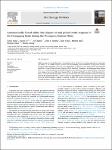Astronomically forced saline lake deposition and paleoclimatic response in the Huanggang Basin during the Paleogene, Eastern China
| dc.contributor.author | Song, C | |
| dc.contributor.author | Lv, D | |
| dc.contributor.author | Chang, J | |
| dc.contributor.author | Ejembi, JI | |
| dc.contributor.author | Tang, L | |
| dc.contributor.author | Raji, M | |
| dc.contributor.author | Chen, W | |
| dc.contributor.author | Zhang, Z | |
| dc.date.accessioned | 2023-08-02T06:27:28Z | |
| dc.date.available | 2023-08-02T06:27:28Z | |
| dc.date.issued | 2023-07 | |
| dc.identifier.issn | 0169-1368 | |
| dc.identifier.issn | 1872-7360 | |
| dc.identifier.other | 105506 | |
| dc.identifier.uri | https://pearl.plymouth.ac.uk/handle/10026.1/21128 | |
| dc.description.abstract |
Halite is a type of evaporite that can be processed into refined salt for food processing, and used as an important raw material in the chemical industry. However, our understanding of the astronomical forcing pattern on halite formation at the sedimentary basin scale is still limited. Here, we present a halite-rich lacustrine record from the middle-late Eocene through the early Oligocene of the Dawenkou Formation in the Huanggang Basin, Eastern China. A ∼ 6.5-Myr-long floating astronomical time scale was constructed based on a 405-kyr orbital eccentricity cycle tuning of gamma-ray (GR) series measured from the Upper and Middle members of the Dawenkou Formation. Our results indicate that halite intervals in the Middle Member of the Dawenkou Formation correspond well with the minima of the 100 kyr orbital eccentricity, suggesting the short eccentricity-induced climatic cycles forcing of halite formation by impact on seasonal contrasts. Our work provides essential context for understanding the pattern of halite deposits from the aspect of climate cycles at the sedimentary basin scale. | |
| dc.format.extent | 105506-105506 | |
| dc.language | en | |
| dc.publisher | Elsevier BV | |
| dc.subject | Halite | |
| dc.subject | Paleoclimate | |
| dc.subject | Astronomical forcing | |
| dc.subject | Short orbital eccentricity | |
| dc.subject | Huanggang Basin | |
| dc.subject | Paleogene | |
| dc.title | Astronomically forced saline lake deposition and paleoclimatic response in the Huanggang Basin during the Paleogene, Eastern China | |
| dc.type | journal-article | |
| dc.type | Article | |
| plymouth.author-url | https://www.webofscience.com/api/gateway?GWVersion=2&SrcApp=PARTNER_APP&SrcAuth=LinksAMR&KeyUT=WOS:001011601200001&DestLinkType=FullRecord&DestApp=ALL_WOS&UsrCustomerID=11bb513d99f797142bcfeffcc58ea008 | |
| plymouth.volume | 158 | |
| plymouth.publisher-url | http://dx.doi.org/10.1016/j.oregeorev.2023.105506 | |
| plymouth.publication-status | Published | |
| plymouth.journal | Ore Geology Reviews | |
| dc.identifier.doi | 10.1016/j.oregeorev.2023.105506 | |
| plymouth.organisational-group | |Plymouth | |
| plymouth.organisational-group | |Plymouth|Faculty of Science and Engineering | |
| plymouth.organisational-group | |Plymouth|Users by role | |
| plymouth.organisational-group | |Plymouth|Users by role|Academics | |
| dcterms.dateAccepted | 2023-05-23 | |
| dc.date.updated | 2023-08-02T06:27:27Z | |
| dc.rights.embargodate | 2023-8-3 | |
| dc.identifier.eissn | 1872-7360 | |
| dc.rights.embargoperiod | forever | |
| rioxxterms.versionofrecord | 10.1016/j.oregeorev.2023.105506 |


